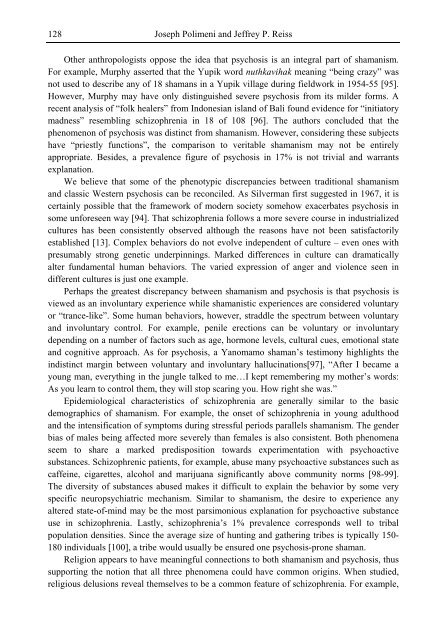Schizophrenia Research Trends
Schizophrenia Research Trends
Schizophrenia Research Trends
- No tags were found...
Create successful ePaper yourself
Turn your PDF publications into a flip-book with our unique Google optimized e-Paper software.
128Joseph Polimeni and Jeffrey P. ReissOther anthropologists oppose the idea that psychosis is an integral part of shamanism.For example, Murphy asserted that the Yupik word nuthkavihak meaning “being crazy” wasnot used to describe any of 18 shamans in a Yupik village during fieldwork in 1954-55 [95].However, Murphy may have only distinguished severe psychosis from its milder forms. Arecent analysis of “folk healers” from Indonesian island of Bali found evidence for “initiatorymadness” resembling schizophrenia in 18 of 108 [96]. The authors concluded that thephenomenon of psychosis was distinct from shamanism. However, considering these subjectshave “priestly functions”, the comparison to veritable shamanism may not be entirelyappropriate. Besides, a prevalence figure of psychosis in 17% is not trivial and warrantsexplanation.We believe that some of the phenotypic discrepancies between traditional shamanismand classic Western psychosis can be reconciled. As Silverman first suggested in 1967, it iscertainly possible that the framework of modern society somehow exacerbates psychosis insome unforeseen way [94]. That schizophrenia follows a more severe course in industrializedcultures has been consistently observed although the reasons have not been satisfactorilyestablished [13]. Complex behaviors do not evolve independent of culture – even ones withpresumably strong genetic underpinnings. Marked differences in culture can dramaticallyalter fundamental human behaviors. The varied expression of anger and violence seen indifferent cultures is just one example.Perhaps the greatest discrepancy between shamanism and psychosis is that psychosis isviewed as an involuntary experience while shamanistic experiences are considered voluntaryor “trance-like”. Some human behaviors, however, straddle the spectrum between voluntaryand involuntary control. For example, penile erections can be voluntary or involuntarydepending on a number of factors such as age, hormone levels, cultural cues, emotional stateand cognitive approach. As for psychosis, a Yanomamo shaman’s testimony highlights theindistinct margin between voluntary and involuntary hallucinations[97], “After I became ayoung man, everything in the jungle talked to me…I kept remembering my mother’s words:As you learn to control them, they will stop scaring you. How right she was.”Epidemiological characteristics of schizophrenia are generally similar to the basicdemographics of shamanism. For example, the onset of schizophrenia in young adulthoodand the intensification of symptoms during stressful periods parallels shamanism. The genderbias of males being affected more severely than females is also consistent. Both phenomenaseem to share a marked predisposition towards experimentation with psychoactivesubstances. Schizophrenic patients, for example, abuse many psychoactive substances such ascaffeine, cigarettes, alcohol and marijuana significantly above community norms [98-99].The diversity of substances abused makes it difficult to explain the behavior by some veryspecific neuropsychiatric mechanism. Similar to shamanism, the desire to experience anyaltered state-of-mind may be the most parsimonious explanation for psychoactive substanceuse in schizophrenia. Lastly, schizophrenia’s 1% prevalence corresponds well to tribalpopulation densities. Since the average size of hunting and gathering tribes is typically 150-180 individuals [100], a tribe would usually be ensured one psychosis-prone shaman.Religion appears to have meaningful connections to both shamanism and psychosis, thussupporting the notion that all three phenomena could have common origins. When studied,religious delusions reveal themselves to be a common feature of schizophrenia. For example,
















